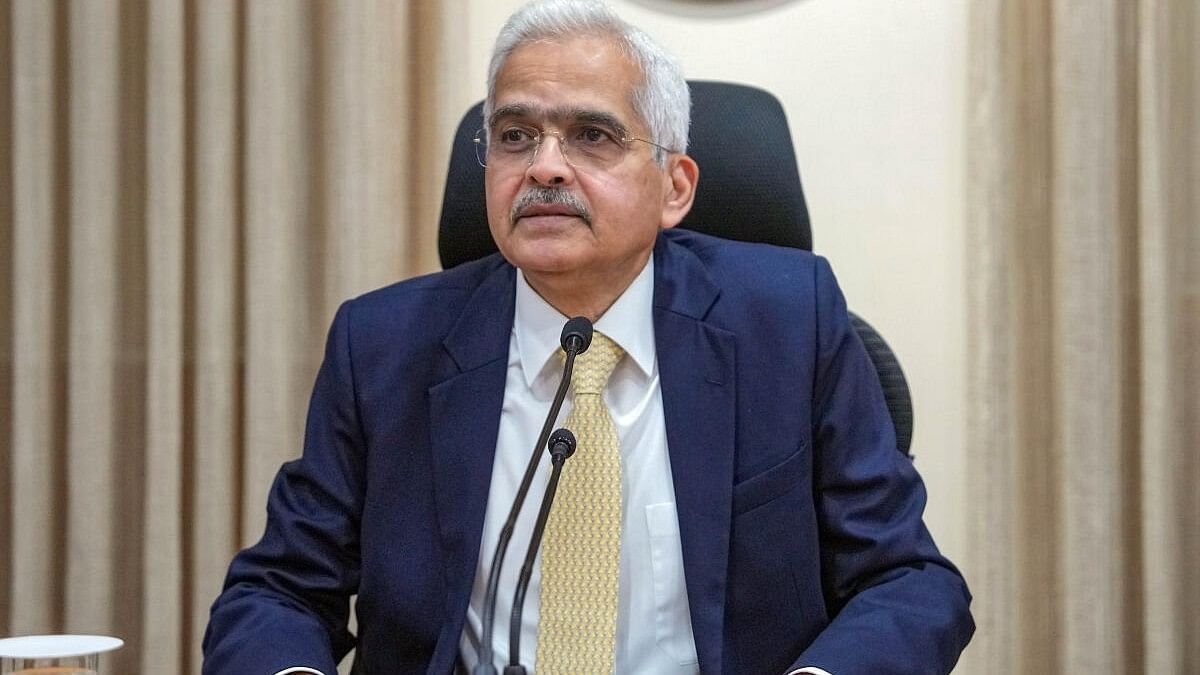
Reserve Bank of India Governor Shaktikanta Das delivers the Monetary Policy Statement, at the RBI headquarters in Mumbai on February 8.
Credit: PTI Photo
In its monetary policy meeting, the Reserve Bank of India (RBI)’s Monetary Policy Committee (MPC) decided to keep the policy repo rate unchanged at 6.5 per cent.
Accordingly, the Standing Deposit Facility Rate and Marginal Standing Facility were also kept unchanged at 6.25 per cent and 6.75 per cent respectively. The decision was in line with market expectations. One surprise was that of the six members, five members voted for status quo, J R Varma voted to cut repo rate by 25 basis points (bps).
The first objective of the RBI is to keep inflation at the target of 4 per cent with a band of +/- 2 per cent. It adopted inflation targeting in 2015, but the formal constitution of MPC started from October 2016 onwards.
The graph below shows that the RBI managed to keep inflation at 4 per cent and lower till 2019. Post-2019, inflation has not just been higher than 4 per cent but also higher than the upper band of 6 per cent. So much so, many market participants now believe that the inflation target to be 6 per cent.
From October 2016 to December 2023 (CPI inflation data is available till December 2023), it has been 87 months of inflation targeting. Of the 87 months, the RBI has managed to keep inflation at 4 per cent or lower for 26 months. Of the remaining 61 months, inflation has been higher than the upper band of 6 per cent for 27 months. Since October 2019, inflation has been higher than 4 per cent for consecutive 51 months and higher than 6 per cent in 27 of those 51 months.
This shows how difficult it has been for the RBI to achieve the 4 per cent inflation target. It was close to achieving the target last year in April-May but again inflation increased sharply to touch 7.4 per cent levels due to higher food prices.
The RBI is expecting inflation for 2023-2024 at 5.4 per cent and for 2024-2025 at 4.5 per cent. It expects inflation to moderate and touch 4 per cent in Q2 2024-2025, assuming a normal monsoon and the absence of supply shocks.
Growth
Coming to growth, the Central Statistical Organisation (CSO) has projected the growth for 2023-2024 at 7.3 per cent. RBI Governor Shaktikanta Das added in his remarks that the Indian economy has grown at 7 per cent and above for three consecutive years. Further, the RBI expects GDP growth for 2024-2025 at 7 per cent with Q1 at 7.2 per cent, Q2 at 6.8 per cent, Q3 at 7.0 per cent, and Q4 at 6.9 per cent.
The RBI projections for inflation and growth suggest that the Indian economy is expected to fare well on both fronts. Given these macroeconomic outcomes, it is surprising that Varma voted for a cut in the repo rate. We must wait for the minutes of the MPC meeting to understand his reasons. The general view is that Varma’s views are different and forward-looking compared to other members. The question is what is it that he is seeing that others are not.
The MPC statement did not discuss the ongoing issue of unravelling of Paytm Payments Bank. In the monetary policy media discussion, there were quite a few questions related to the failed entity. Das said that the RBI will issue FAQs next week clarifying the issues, and matters related to Paytm Payments Bank.
Keep pace
The RBI also releases regulatory and market development policies along with the MPC statement. The RBI has taken some interesting measures to simplify loan process, deepen digital payments and increase circulation of central bank digital currency.
First, all the regulated entities will be required to provide ‘Key Fact Statement’ (KFS) to the borrowers for all retail and MSME loans. The KFS is a document shared by the borrowers which mentions, apart from the interest rate, other fees and charges such as processing fees, documentation charges, etc. The KFS helps build transparency between banks and customers. So far, the KFS has been applicable for limited cases: scheduled commercial banks to individual borrowers; digital lending by regulated entities (Res); and microfinance loans. Now it has been extended to all the regulated entities (banks, NBFCs, co-operative banks, housing finance companies) for all retail and MSME loans.
Second, the RBI has proposed to adopt a principle-based ‘Framework for authentication of digital payment transactions’. As of now, One Time Password (OTP) is used for authenticating digital transactions. With new technologies, there is a need to look at the other technologies which can used for authenticating digital transactions. The proposed framework will help identify the new technologies which will help the public overtime.
Third, the RBI has decided to extend its pilot project of Retail Central Bank Digital Currency Retail (CBDC-R) to other pilot projects. So far CBDC-R pilot enabled Person to Person (P2P) and Person to Merchant (P2M) transactions using Digital Rupee wallets provided by select banks. The RBI now proposes to allow programmability and offline functionality of CBDC-R.
Under programmability, one can programme the currency to achieve desired benefits. The examples given by RBI are government agencies targeting transfer payments for defined benefits and corporates designing specific expenditures like business travel for their employees. Under offline functionality, the central bank proposes that CBDC-R transactions can be done in offline mode as well. There are areas that have poor or limited Internet connectivity and offline CBDC-R will be helpful in such locations.
(Amol Agrawal is an economist teaching at Ahmedabad University.)
Disclaimer: The views expressed above are the author's own. They do not necessarily reflect the views of DH.